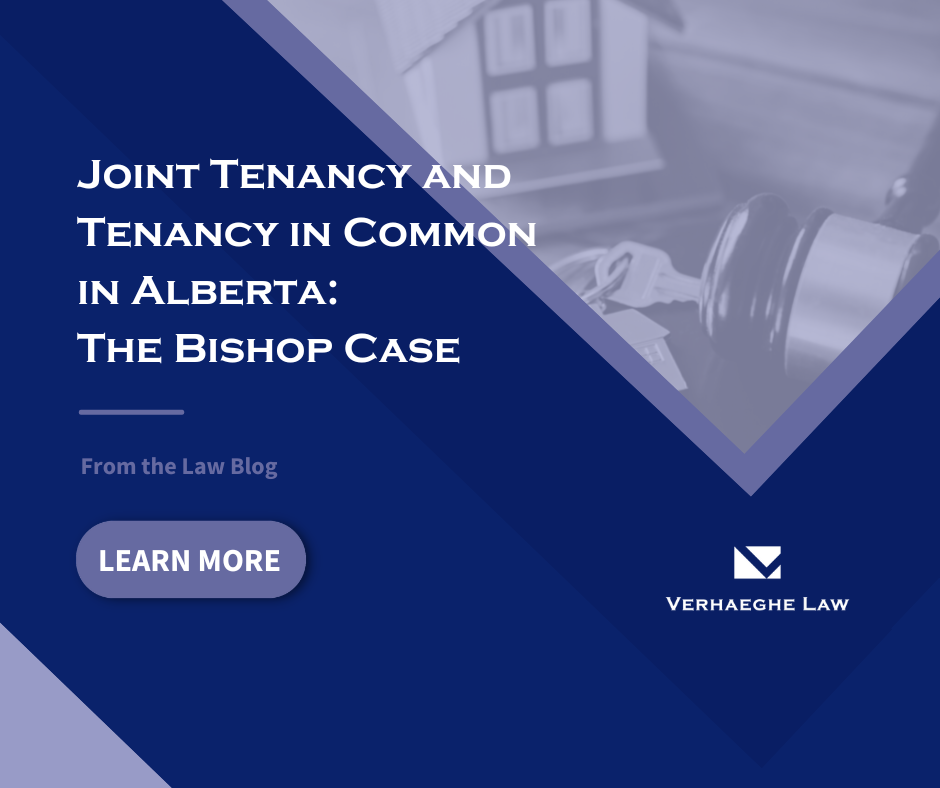Joint Tenancy and Tenancy in Common in Alberta The Bishop Case

When a person dies, their estate is typically distributed amongst their beneficiaries. This may be their spouse, children, grandchildren, or other individuals named in the deceased’s last will and testament. If the deceased co-owned property in a joint tenancy with another person, then the surviving title-holder usually gains full ownership of said property through the automatic right of survivorship.
However, there are some exceptions. In a 2022 case involving a contested division of property, a beneficiary successfully argued that her deceased father’s joint tenancy with his ex-wife had been severed, and therefore the ex-wife would not assume the automatic right of survivorship.
This case illustrates an important consideration for divorcing couples who co-own property, as it is possible for a court to rule a joint tenancy severed. To learn more on how to navigate division of property through a separation or divorce, or what to do when the division of estate assets is contested, contact our Edmonton estate administration lawyers for a consultation.
Joint Tenancy vs Tenancy in Common
Both joint tenancy and tenancy in common are terms referring to co-ownership of an estate. In a joint tenancy, the co-owners share undivided possession of the property, commencing simultaneously and through the same conveyance, and with a shared interest. Joint tenancy is likewise characterized by the right of survivorship, meaning that if one joint tenant dies, the other(s) automatically assume ownership of the property.
A tenancy in common, meanwhile, has only the unity of possession, and no right of survivorship. A tenant in common may make decisions regarding their share of the property independent of their fellow owners. They may, for instance, bequeath their interest to beneficiaries through a will.
A joint tenancy may severed and made into a tenancy in common in one of three ways:
- Mutual agreement between joint tenants;
- The sale of one or more tenants’ interest in the property; or
- Providing evidence that the co-owners have treated the property as a tenancy in common.
The distinction between joint tenancy and tenancy in common lies at the centre of the aforementioned 2022 case.
The Bishop Case
David Bishop was married to Theresa Louise May for many years, then divorced in 2013 following a long separation. As joint tenants, they co-owned a house in Calgary. Bishop died intestate, meaning he did not have a will, leaving behind three children from a previous relationship as his beneficiaries.
Following Bishop’s death, May sold the property, intending to receive the entirety of the proceeds as the surviving joint tenant. Bishop’s daughter, Stephanie Drag, contested this. While May was indeed a joint tenant on the property title, she had not lived at the property in many years, and Bishop had assumed the vast majority of costs associated with its upkeep. Additionally, there was corroborated evidence that Bishop and May had a verbal agreement that she would receive $100,000 from the property’s proceeds after his death. This constituted just over one-third of the total proceeds amount.
Having weighed the considerations presented before the court, Honourable Mr. Justice O.P. Malik ruled that the joint tenancy had been severed, and should be treated as a tenancy in common. May would get her agreed-upon share, and the remainder would go to the beneficiaries of the estate.
Considerations in Divorce Cases
The Bishop case illuminates a key consideration for couples in questions concerning property, estates, probates and wills. Whether entering into a marriage or common-law relationship, or navigating a separation or divorce, it is important to specify how property will be divided after the death of one of the co-owners.
As in the Bishop case, this consideration can be especially nuanced when there is involvement of beneficiaries such as children from another relationship. Clear, informed documentation, including the preparation of a last will and testament, can help mitigate confusion and conflict following a property-owner’s death.
Contact Our Edmonton Estate Administration Lawyers Today for a Consultation
It is unfortunate that the process of estate administration is not always smooth, particularly where a divorce or separation is involved. Our Edmonton estate administration lawyers can discuss the specifics of your circumstances, and may be able to help you navigate a range of property division questions, from divorce considerations to estate litigation, and more. Contact us today to learn how we may be of service to you.
** Please note, this article is intended as a general overview on a legal subject, and does not constitute legal advice. For legal advice, please consult with a lawyer.
